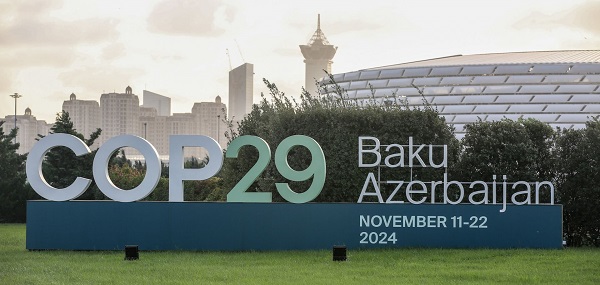Energy
COP 29 is immoral


Energy Talking Points
By Alex Epstein
COP 29 seeks net-zero, which would radically increase climate danger and ruin billions of lives
COP 29 seeks net-zero—rapidly eliminating fossil fuels—in the name of protecting us from climate danger.
In reality, net-zero would radically increase climate danger and ruin billions of lives.
People should condemn COP and embrace energy freedom.
- The COP 29 climate conference has a consistent theme: previous COPs have done an okay job of restricting fossil fuels in the name of reducing greenhouse gas emissions, but this one needs to eliminate fossil fuel use far faster so as to reach net-zero by 2050.This is 180° wrong.
- COP 29’s goal of rapidly eliminating fossil fuels to reach net-zero is deadly because:1. Fossil fuels are making us far safer from climate along with improving every other aspect of life
2. Even barely implementing COP’s net-zero agenda has been disastrous.
Fossil fuels are making us far safer from climate.
- The justification of COP 29’s net-zero agenda is that fossil fuel use is causing an escalating “climate crisis.”But if we look at the full effects of fossil fuels on climate danger, we find that overall fossil fuels have dramatically reduced climate danger.
- Myth: Climate danger is higher than ever because of fossil fuels’ CO2 emissions.Truth: We have a 98% decline in climate disaster deaths due to our enormous fossil-fueled climate mastery abilities: heating and cooling, infrastructure-building, irrigation, crop transport.¹
- Myth: Mainstream science shows that rising CO2 is an “existential threat” that will soon cause global catastrophe and then apocalypse.Truth: Mainstream science shows that rising CO2 levels will lead to levels of warming and other changes that we can master and flourish with.
- For the full story on how fossil fuels overall make us far safer from climate and will continue to do so, read this:
The climate safety denial movement
·Jan 25Read full story
Even barely implementing COP 29’s net-zero agenda has been disastrous.
- While COP 28 leaders bemoan how slow their restriction of fossil fuels in pursuit of net-zero has been, even “slow” restriction has caused a global energy crisis.
- Myth: Net-zero policies are new and exciting.Truth: Net-zero policies have caused catastrophic energy shortages even with minuscule implementation. Just by slowing the growth of fossil fuel use, not even reducing it, they have caused global energy shortages advocates didn’t warn us of.
- Minuscule net-zero policies causing huge problems:US: frequent power shortages after shutting down fossil fuel power plants.
EU: deadly fossil fuel dependence after restricting their domestic fossil fuel industry.
Poor nations: can’t afford fuel due to global restrictions.²
- If just restricting the growth of fossil fuels in a world that needs far more energy is catastrophic, what would it mean to reduce CO2 emissions by the 50% many “climate emergency” advocates want by 2030 and the 100% they want by 2050?Global misery and premature death.
Every “net zero by 2050” myth, refuted
·September 21, 2023Read full story
COP 29’s net-zero agenda harms poor nations most of all.
- The net-zero movement led by COP is particularly dangerous to Africa and other poor regions.Consider: 1/3 of the world uses wood and animal dung for heating and cooking. 3 billion use less electricity than a typical American refrigerator.
Only fossil fuels can provide the energy they need to develop.³
- Every prosperous country has developed using fossil fuels.No poor country has been able to develop to the point of prosperity without massive fossil fuel use.
Development requires energy, and fossil fuels are a uniquely cost-effective and scalable source of energy.⁴
- Fossil fuels are so uniquely good at providing low-cost, reliable energy for developing nations that even nations with little or no fossil fuel resources have used fossil fuels to develop and prosper. E.g. South Korea (83% fossil fuels), Japan (85% fossil fuels), Singapore (99% fossil fuels).⁵
- The obvious path for African development and prosperity is to use fossil fuel whenever it’s the most cost-effective option, which is most of the time, and certainly to responsibly produce the significant fossil fuel resources that exist in Africa.Yet COP tells Africa to forgo fossil fuels.
- COP 29 is fundamentally immoral because its goal of “net zero by 2050” would deprive billions of the energy they need to prosper.Good people who care about energy and human flourishing should condemn COP and net-zero can champion energy freedom instead.
The path forward: reject net-zero and embrace energy freedom.
- The path to global prosperity and increasing climate safety is energy freedom: allowing us to use all forms of energy so we are prosperous, resilient to climate danger, and in the long-term innovate new, truly cost-effective alternatives to fossil fuels.
- Rejecting net-zero and embracing energy freedom means scrapping the Paris Agreement, whose pursuit of net-zero is committing virtually all nations, including the world’s poorest, to rejecting the fossil fuels they need to prosper.
- While many at COP are saying that a US withdrawal from Paris by the next administration would be irresponsible, it is the only responsible action to take given that Paris commits us to banning most of the fossil fuels that we and our allies need.
- Rejecting net-zero, including the Paris Agreement, and embracing energy freedom requires collaboration among pro-freedom countries like the US, developing nations such as African nations, and any reasonable energy companies.
- Developing nations, above all African nations, need to reject net-zero and embrace energy freedom: the freedom to produce and use all cost-effective sources of energy—including, essentially, fossil fuels—which means rejecting all net-zero targets. Here’s a blueprint for doing it.
My Message to Leaders at African Energy Week 2023
·October 17, 2023Read full story - The energy industry and obviously the fossil fuel industry should condemn COP and its net-zero goal. Appalling, ExxonMobil and others are actually calling for the US to stay in the net-zero Paris Agreement!Here’s why this is both immoral and impractical.
The lesson of fossil fuel advocates’ failure at COP 28: stop “Arguing to 0,” start “Arguing to 100”
·December 14, 2023Read full story - Any attendee of COP 29 should thoroughly reject the conference’s “net zero by 2050” goal and instead proudly advocate for energy freedom and climate safety through climate mastery.If they do that, they have a real chance at stopping the conference from ruining the world.
Popular links
- EnergyTalkingPoints.com: Hundreds of concise, powerful, well-referenced talking points on energy, environmental, and climate issues.
- My new book Fossil Future: Why Global Human Flourishing Requires More Oil, Coal, and Natural Gas—Not Less.
- Speaking and media inquiries
“Energy Talking Points by Alex Epstein” is my free Substack newsletter designed to give as many people as possible access to concise, powerful, well-referenced talking points on the latest energy, environmental, and climate issues from a pro-human, pro-energy perspective.
Share Energy Talking Points by Alex Epstein
1
UC San Diego – The Keeling Curve
For every million people on earth, annual deaths from climate-related causes (extreme temperature, drought, flood, storms, wildfires) declined 98%–from an average of 247 per year during the 1920s to 2.5 per year during the 2010s.
Data on disaster deaths come from EM-DAT, CRED / UCLouvain, Brussels, Belgium – www.emdat.be (D. Guha-Sapir).
Population estimates for the 1920s from the Maddison Database 2010, the Groningen Growth and Development Centre, Faculty of Economics and Business at University of Groningen. For years not shown, population is assumed to have grown at a steady rate.
Population estimates for the 2010s come from World Bank Data.
2
3
Business
Natural gas pipeline ownership spreads across 36 First Nations in B.C.

Chief David Jimmie is president of Stonlasec8 and Chief of Squiala First Nation in B.C. He also chairs the Western Indigenous Pipeline Group. Photo courtesy Western Indigenous Pipeline Group
From the Canadian Energy Centre
Stonlasec8 agreement is Canada’s first federal Indigenous loan guarantee
The first federally backed Indigenous loan guarantee paves the way for increased prosperity for 36 First Nations communities in British Columbia.
In May, Canada Development Investment Corporation (CDEV) announced a $400 million backstop for the consortium to jointly purchase 12.5 per cent ownership of Enbridge’s Westcoast natural gas pipeline system for $712 million.
In the works for two years, the deal redefines long-standing relationships around a pipeline that has been in operation for generations.
“For 65 years, there’s never been an opportunity or a conversation about participating in an asset that’s come through the territory,” said Chief David Jimmie of the Squiala First Nation near Vancouver, B.C.
“We now have an opportunity to have our Nation’s voices heard directly when we have concerns and our partners are willing to listen.”
Jimmie chairs the Stonlasec8 Indigenous Alliance, which represents the communities buying into the Enbridge system.
The name Stonlasec8 reflects the different regions represented in the agreement, he said.
The Westcoast pipeline stretches more than 2,900 kilometres from northeast B.C. near the Alberta border to the Canada-U.S. border near Bellingham, Wash., running through the middle of the province.

It delivers up to 3.6 billion cubic feet per day of natural gas throughout B.C. and the Lower Mainland, Alberta and the U.S. Pacific Northwest.
“While we see the benefits back to communities, we are still reminded of our responsibility to the land, air and water so it is important to think of reinvestment opportunities in alternative energy sources and how we can offset the carbon footprint,” Jimmie said.
He also chairs the Western Indigenous Pipeline Group (WIPG), a coalition of First Nations communities working in partnership with Pembina Pipeline to secure an ownership stake in the newly expanded Trans Mountain pipeline system.
There is overlap between the communities in the two groups, he said.
CDEV vice-president Sébastien Labelle said provincial models such as the Alberta Indigenous Opportunities Corporation (AIOC) and Ontario’s Indigenous Opportunities Financing Program helped bring the federal government’s version of the loan guarantee to life.
“It’s not a new idea. Alberta started it before us, and Ontario,” Labelle said.
“We hired some of the same advisors AIOC hired because we want to make sure we are aligned with the market. We didn’t want to start something completely new.”
Broadly, Jimmie said the Stonlasec8 agreement will provide sustained funding for investments like housing, infrastructure, environmental stewardship and cultural preservation. But it’s up to the individual communities how to spend the ongoing proceeds.
The long-term cash injections from owning equity stakes of major projects can provide benefits that traditional funding agreements with the federal government do not, he said.
Labelle said the goal is to ensure Indigenous communities benefit from projects on their traditional territories.
“There’s a lot of intangible, indirect things that I think are hugely important from an economic perspective,” he said.
“You are improving the relationship with pipeline companies, you are improving social license to do projects like this.”
Jimmie stressed the impact the collaborative atmosphere of the negotiations had on the success of the Stonlasec8 agreement.
“It takes true collaboration to reach a successful partnership, which doesn’t always happen. And from the Nation representation, the sophistication of the group was one of the best I’ve ever worked with.”
Alberta
Alberta Premier Danielle Smith Discusses Moving Energy Forward at the Global Energy Show in Calgary

From Energy Now
At the energy conference in Calgary, Alberta Premier Danielle Smith pressed the case for building infrastructure to move provincial products to international markets, via a transportation and energy corridor to British Columbia.
“The anchor tenant for this corridor must be a 42-inch pipeline, moving one million incremental barrels of oil to those global markets. And we can’t stop there,” she told the audience.
The premier reiterated her support for new pipelines north to Grays Bay in Nunavut, east to Churchill, Man., and potentially a new version of Energy East.
The discussion comes as Prime Minister Mark Carney and his government are assembling a list of major projects of national interest to fast-track for approval.
Carney has also pledged to establish a major project review office that would issue decisions within two years, instead of five.
-

 Crime15 hours ago
Crime15 hours agoHow Chinese State-Linked Networks Replaced the Medellín Model with Global Logistics and Political Protection
-

 Addictions16 hours ago
Addictions16 hours agoNew RCMP program steering opioid addicted towards treatment and recovery
-

 Aristotle Foundation17 hours ago
Aristotle Foundation17 hours agoWe need an immigration policy that will serve all Canadians
-

 Business14 hours ago
Business14 hours agoNatural gas pipeline ownership spreads across 36 First Nations in B.C.
-

 Courageous Discourse12 hours ago
Courageous Discourse12 hours agoHealthcare Blockbuster – RFK Jr removes all 17 members of CDC Vaccine Advisory Panel!
-

 Health8 hours ago
Health8 hours agoRFK Jr. purges CDC vaccine panel, citing decades of ‘skewed science’
-

 Censorship Industrial Complex11 hours ago
Censorship Industrial Complex11 hours agoAlberta senator wants to revive lapsed Trudeau internet censorship bill
-

 Crime18 hours ago
Crime18 hours agoLetter Shows Biden Administration Privately Warned B.C. on Fentanyl Threat Years Before Patel’s Public Bombshells










